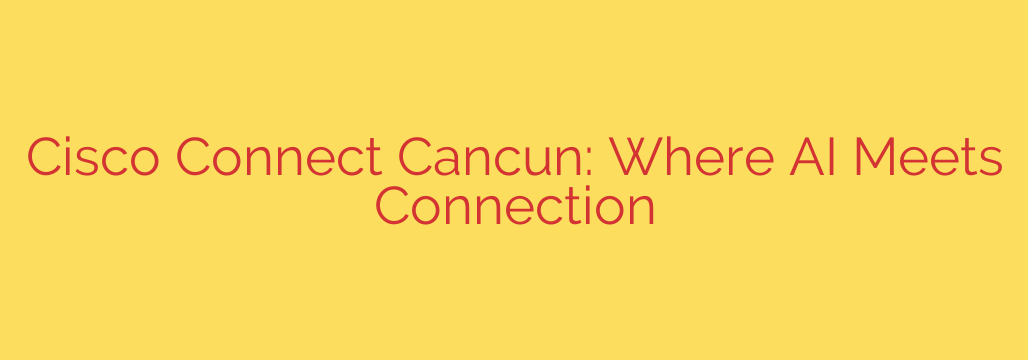
The Future of Digital Resilience: Unifying AI, Security, and Networking
In today’s hyper-connected world, the lines between networking, cybersecurity, and data analytics are blurring. Digital transformation has expanded the attack surface, while the rise of artificial intelligence presents both unprecedented opportunities and sophisticated new threats. To navigate this complex landscape, organizations must move beyond siloed solutions and embrace a unified, AI-driven approach to digital resilience. The future belongs to those who can see, predict, and act on data across their entire technological footprint.
A major shift is underway, underscored by strategic moves like Cisco’s recent $28 billion acquisition of Splunk. This isn’t just a business transaction; it’s a clear signal of where the industry is heading. By combining deep network visibility with market-leading security and observability, the goal is to create a comprehensive view of an organization’s digital infrastructure. The integration of Cisco’s network infrastructure with Splunk’s data platform creates a powerful end-to-end view of the entire digital landscape, from user to application. This unified data is the fuel for next-generation, AI-powered security and operations.
Introducing AI-Native Security Architecture
For years, security has been a reactive discipline, focused on building walls around a well-defined perimeter. But in an era of cloud computing, remote work, and distributed applications, the perimeter has dissolved. The new frontier of defense is an AI-native security model, designed to protect workloads and data wherever they reside.
A prime example of this evolution is the concept of a “Hypershield.” This isn’t a single product but an entirely new security architecture woven directly into the fabric of the network. It leverages the power of AI to automate and enforce security policies at a granular level. Instead of relying on manual configuration, an AI-native system can learn the baseline behavior of an environment and automatically segment workloads, isolate threats, and adapt its defenses in real time.
Key characteristics of an AI-native security architecture include:
- Autonomous Segmentation: It automatically creates and enforces micro-segmentation policies, drastically reducing the lateral movement of attackers within a network.
- Distributed Enforcement: Security controls are moved from centralized appliances directly to the workloads they are protecting, whether in a public cloud or a private data center.
- Self-Managing Upgrades: It handles complex software upgrades and patching autonomously, ensuring defenses are always current without disruptive downtime.
This approach fundamentally changes the security paradigm from “detect and respond” to “predict and prevent,” using AI to anticipate threats and neutralize them before they can cause damage.
The Power of a Unified Security Platform
The average enterprise uses dozens of disconnected security tools, creating operational complexity, visibility gaps, and alert fatigue for security teams. A unified platform approach, like the Cisco Security Cloud, aims to solve this problem by integrating various security functions into a single, cohesive ecosystem.
When threat intelligence, endpoint security, firewalls, and analytics tools work together, the result is greater than the sum of its parts. A unified security platform simplifies complexity, enabling security teams to detect and respond to threats faster and more effectively across their entire environment. This integration allows for a common policy engine and a shared understanding of threats, whether they originate from the network, the cloud, or an endpoint device.
Actionable Steps for a More Secure Future
Navigating this new era of security requires a strategic shift in mindset and technology. Here are three actionable steps organizations can take to build a more resilient digital infrastructure:
Prioritize End-to-End Observability: You cannot protect what you cannot see. Invest in solutions that provide deep visibility across your entire IT environment, including networks, applications, and cloud services. Full-stack observability is the foundation for effective security and operational decision-making.
Consolidate and Integrate Your Security Tools: Move away from a collection of point solutions and toward an integrated security platform. This reduces management overhead, closes security gaps, and empowers your teams with a single source of truth for threat detection and response.
Prepare for an AI-Powered Future: Begin exploring and adopting AI-driven security tools. These technologies are no longer theoretical; they are essential for automating defenses, identifying sophisticated anomalies, and scaling security operations to meet the challenges of the modern threat landscape.
Ultimately, the convergence of networking, security, and observability, all powered by AI, is the definitive path forward. By breaking down internal silos and adopting a unified platform strategy, businesses can not only defend against today’s threats but also build a secure and resilient foundation for future innovation.
Source: https://feedpress.me/link/23532/17173646/experience-the-power-of-connection-and-ai-at-cisco-connect-cancun








